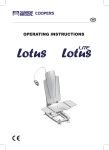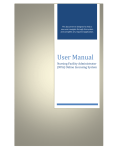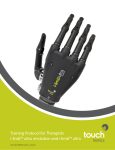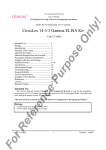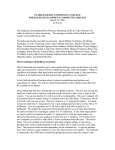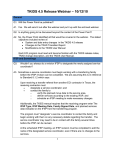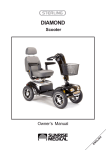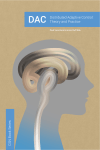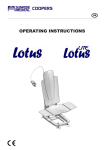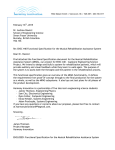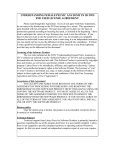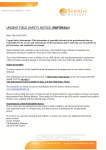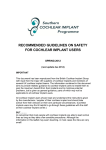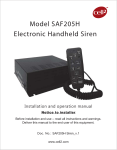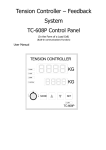Download Move With POWER! - Sunrise Medical
Transcript
6/16/2014 Move With POWER! An Introductory Overview of Power Wheelchairs, Seating, & Electronics Presented by: Steve Boucher OTR/L, ATP & Angie Kiger, M.Ed., CTRS, ATP/SMS Clinical Education Specialists, Sunrise Medical LLC MANUAL POWER ADULT PEDIATRICS SEATING GERIATRICS CONTROLS FUNDING Seminar Content Disclosure • The authors and presenters of the Sunrise Training & Education Programs (STEPS) are full-time employees of Sunrise Medical. • We do not intend to endorse any particular model, brand of product or manufacturer. CONFIDENTIAL AND PROPRIETARY Duplication or Distribution Prohibited 6-2014 2 Course Objectives Upon completion of this course, participants will be able to: • Articulate the steps required to complete a thorough power mobility evaluation. • List at least 2 differences in the performance of a rear wheel drive, front wheel drive, and mid-wheel drive power wheelchair on uphill, downhill, and even surfaces • State 3 clinical justifications for each dynamic power seating functions including tilt, recline, elevating leg rests, and seat elevate. • Define the differences between expandable and non-expandable electronics CONFIDENTIAL AND PROPRIETARY Duplication or Distribution Prohibited 6-2014 3 1 6/16/2014 Housekeeping Breaks Restrooms Handouts CEUs CONFIDENTIAL AND PROPRIETARY Duplication or Distribution Prohibited 6-2014 4 CEU Requirements • • • • IACET CEU CREDIT Must be paid in full Must sign in at the registration table Must provide last 4 of your SSN – If you didn’t provide it when you pre-registered, there will not be a certificate onsite – You can still provide the last 4 of your SSN now on your evaluation, certificate will be provided within 45 days • Must complete the evaluation form and turn it in at the close of the seminar • It is a requirement that to receive CEU credit, you must attend the full course CONFIDENTIAL AND PROPRIETARY Duplication or Distribution Prohibited 6-2014 5 AGENDA 60 minutes Introduction to Power Mobility & Funding 60 minutes Evaluation & Seating Options 15 minutes Break 30 minutes Base Options 30 minutes Electronics & Programming 30 minutes Recommendations & Training 15 minutes Documentation 15 minutes Questions & Wrap-up CONFIDENTIAL AND PROPRIETARY Duplication or Distribution Prohibited 6-2014 6 2 6/16/2014 Words of Wisdom • “Technology does not DRIVE change…it enables change.” - Anonymous • “Continuous effort – not strength or intelligence – is the key to unlocking your potential.” - Winston Churchill • “Being able to drive a power chair has opened up a world for our son that experts always told us we could only dream of…We will NEVER get tired of chasing him!” – Parent of an end user! CONFIDENTIAL AND PROPRIETARY Duplication or Distribution Prohibited 6-2014 7 Pieces of the Power Puzzle Power Base Seating Funding Access Dynamic positioning Evaluation Electronics & Programming CONFIDENTIAL AND PROPRIETARY Duplication or Distribution Prohibited 6-2014 8 Pieces of the Power Puzzle Funding Evaluation Seating & Positioning Power base Electronics & Programming Training & Documentation CONFIDENTIAL AND PROPRIETARY Duplication or Distribution Prohibited 6-2014 9 3 6/16/2014 Critical Questions • Who is the funding source? • What is the client’s medical history? – Diagnosis (primary, secondary, etc.) – Surgeries (previous and upcoming) – Medications (past, present, future) • What equipment has the patient had? – Not just wheelchairs – When was it received, why does it no longer meet their needs (medical - primary)? Who funded the equipment? CONFIDENTIAL AND PROPRIETARY Duplication or Distribution Prohibited 6-2014 10 Common Funding Sources • • • • • • State Medicaid Programs Private Insurance Medicare Worker’s Compensation Veterans Affairs How does secondary insurance work? – Will it matter to you? • Others…? CONFIDENTIAL AND PROPRIETARY Duplication or Distribution Prohibited 6-2014 11 The First Steps Preparation….. • Think about… Who will review the letter or request for funding? • What is this person’s medical background? Do they have an understanding of the Durable Medical Equipment (DME) world that we live in every day? • Remember… The reviewer only knows your patient by what is on paper. It is your job to “tell” the detailed story. • Make a game-plan to keep it simple! CONFIDENTIAL AND PROPRIETARY Duplication or Distribution Prohibited 6-2014 12 4 6/16/2014 Simplify Your time is limited… • As you go through your evaluation, keep in mind that at the same time you are also creating your documentation. • Think about “climbing a ladder” to justify the equipment selected. • Tie your thought process and selections to what will be down on paper. CONFIDENTIAL AND PROPRIETARY Duplication or Distribution Prohibited 6-2014 13 Pieces of the Power Puzzle Funding Evaluation Seating & Positioning Power base Electronics & Programming CONFIDENTIAL AND PROPRIETARY Duplication or Distribution Prohibited 6-2014 14 Who is Appropriate For Power?? CONFIDENTIAL AND PROPRIETARY Duplication or Distribution Prohibited 6-2014 15 5 6/16/2014 Understanding Power Mobility Myths Providing power mobility will: • Cause a decrease in independence or function • Will encourage a person to become lazy • Prevent a client from ever walking or propelling manually • Eliminate the use of the end user’s manual wheelchair which is how they currently exercise! CONFIDENTIAL AND PROPRIETARY Duplication or Distribution Prohibited 6-2014 16 Is a client appropriate for Power? To be appropriate for power, client does not: • • • • • Need to show a certain set of motor skills Need a certain set of cognitive abilities Need to show proficiency in all driving skills right away Be completely unable to ambulate or propel manually Need to be a certain age CONFIDENTIAL AND PROPRIETARY Duplication or Distribution Prohibited 6-2014 17 Power: To Whom? & Where? WHERE? WHOM? • Individuals with diagnoses that may include: – – – – – – • • Spinal Cord Injury (SCI) Cerebral Palsy (CP) Muscular Dystrophy (MD) Traumatic Brain Injury (TBI) Multiple Sclerosis (MS) Amyotrophic Lateral Sclerosis (ALS) • • • • Work School Community mobility Vocational use Clients of all ages (pediatrics to geriatrics) Long term manual wheelchair users CONFIDENTIAL AND PROPRIETARY Duplication or Distribution Prohibited 6-2014 18 6 6/16/2014 Pediatrics and Power • Children develop thru exploration/stimulation • Children without physical impairments begin mobility at ~12 mo • Give children with disabilities the same opportunities – Introduction to power mobility as young as 12-18 months – Time and practice to learn and make mistakes – Appropriate supervision • Marginal ambulation or manual propulsion: – Risk of stress/damage to muscles, joints – Requires energy and endurance – Reduces energy available for other activities CONFIDENTIAL AND PROPRIETARY Duplication or Distribution Prohibited 6-2014 19 Geriatrics and Power Is anyone ever “too old” to utilize power?? • • • • Maintain independent mobility Maximize function Provide energy conservation Protect/conserve upper extremity (UE) function and health • Increase socialization • Increase self esteem and motivation • Improve quality of life CONFIDENTIAL AND PROPRIETARY Duplication or Distribution Prohibited 6-2014 20 Long Term Manual Chair Users • Manual wheelchair propulsion involves: – UE muscles propelling weight of chair and user – UE muscles/joints used in abnormal positions – UE muscles are over-stretched and overused • With pre-existing injury: – Muscle imbalance already exists due to weakness or paralysis of specific muscles • At some point powered mobility becomes a safer, more functional option CONFIDENTIAL AND PROPRIETARY Duplication or Distribution Prohibited 6-2014 21 7 6/16/2014 Bariatric Considerations • Dimensions • Weight • Altered body proportions – Increased tissue in the buttocks and lower back – Increased thigh and abdominal tissue – Distribution of weight • Increased risk of RSI and physiological stresses (e.g. cardiac) due to weight and ergonomics CONFIDENTIAL AND PROPRIETARY Duplication or Distribution Prohibited 6-2014 22 Clinical Best Practices • Are there any related to seating and mobility? • What would they be? CONFIDENTIAL AND PROPRIETARY Duplication or Distribution Prohibited 6-2014 23 Key Assessment Information Endurance CardioPulmonary Status Strength, ROM Ortho Status Tone Reimbursable Non-Reimbursable Sitting Tolerance Or Comfort Cognition, Vision Evaluation Acceptance Power Mobility Change Size/ Weight Function Access to Fun Environmental Needs: Access to Terrain Seating & Positioning Needs Function & Mobility Access to Vocation CONFIDENTIAL AND PROPRIETARY Duplication or Distribution Prohibited 6-2014 24 8 6/16/2014 Prior to the Evaluation • Completion of an intake form by the client and/or caregiver. Information should include: – – – – – Funding Goals of the evaluation Brief case history Current level of function AT experience • Contact other team members including assistive living, outpatient, and/or school/day treatment programs. • Arrange for loaner equipment (i.e. power w/c, alternative controls, etc.) as needed CONFIDENTIAL AND PROPRIETARY Duplication or Distribution Prohibited 6-2014 25 During the Evaluation • Explain the purpose and process of the evaluation • Review goals, funding, and case history • Current medical status and level of function • Evaluate status in current equipment as appropriate • Screen cognitive, visual, and hearing status • Complete a physical assessment and mat evaluation • Environment assessment and transportation discussion • Driving assessment CONFIDENTIAL AND PROPRIETARY Duplication or Distribution Prohibited 6-2014 26 Prior to Getting Your Client “Behind the Wheel” • Observe the client’s movement patterns while in his/her seating system and on a mat/flat surface. • If the client has other AT devices (i.e. communication devices, tablet computer, switches, etc.), ask the client to demonstrate how he/she uses the item(s). • Set-up the seating system so that the client is in most functional position for his/her movements. • Identify activities or items that are highly motivating to the client . • Ensure that the client is positioned for function as opposed to perfection. CONFIDENTIAL AND PROPRIETARY Duplication or Distribution Prohibited 6-2014 27 9 6/16/2014 Questions to consider • Does the client have a progressive condition? • What type of postural support / seating? • Is dynamic seating medically necessary? • Where will the chair be utilized? • How might the client operate the chair? • What other devices will the client be controlling through their wheelchair? CONFIDENTIAL AND PROPRIETARY Duplication or Distribution Prohibited 6-2014 28 After the Evaluation • Review recommendations of equipment and/or therapeutic as appropriate with the client and caregivers. • Discuss the client’s and/or caregiver’s responsibilities in the process and the next steps. • Ensure that the client and/or caregiver are in agreement with the plan. • Review order and funding process, including potential delivery timeframe for recommended equipment. • Provide contact information and an overview of the evaluation to the client and/or caregiver. CONFIDENTIAL AND PROPRIETARY Duplication or Distribution Prohibited 6-2014 29 Where Do We Stumble? • Sometimes shortcuts are taken with the evaluation • Sometimes trial is not possible • Sometimes we battle with the conflict between therapeutic perfection – safety and function. • Sometimes we do not find out or understand their funding situation before the evaluation. CONFIDENTIAL AND PROPRIETARY Duplication or Distribution Prohibited 6-2014 30 10 6/16/2014 Pieces of the Power Puzzle Funding Evaluation Seating & Positioning Power base Electronics & Programming Training & Documentation CONFIDENTIAL AND PROPRIETARY Duplication or Distribution Prohibited 6-2014 31 Seating and Positioning For each client, consider: • Size needed • Potential for growth or weight change • Potential for change in function • Postural control and positioning needs – Seat/back angle and contour – Pelvic, trunk or head positioning supports – Skin protection material • Need for dynamic positioning CONFIDENTIAL AND PROPRIETARY Duplication or Distribution Prohibited 6-2014 32 Seating and Positioning Dynamic Seating Captain’s Seat Modular and Rehab Seat CONFIDENTIAL AND PROPRIETARY Duplication or Distribution Prohibited 6-2014 33 11 6/16/2014 Captain’s Seat Appropriate client: • Fits in standard seat sizes • Maintains optimal posture with: – – – – Standard back height No positioning supports Minimal contour Minimal seat to back angle adjustment • Does not require dynamic seating • Needs comfortable seating • Ability to independently complete weight shifts CONFIDENTIAL AND PROPRIETARY Duplication or Distribution Prohibited 6-2014 34 Rehab Seat Appropriate client: • Requires specific seat/back size • Might require seat depth growth • To maintain posture requires: – – – – Specific back height Positioning supports Specific seat or back contour Specific seat to back angle • Might require some dynamic seating CONFIDENTIAL AND PROPRIETARY Duplication or Distribution Prohibited 6-2014 35 Modular Seating • Clients can change in size, function, cognition and environment • Changes due to progressive condition, recovery, aging and/or medical intervention • Appropriate system should: – Meet current needs – Have modularity to adapt to changing needs • Equipment changes should be: – Economical and easy to do – Cause least amount of disruption to client CONFIDENTIAL AND PROPRIETARY Duplication or Distribution Prohibited 6-2014 36 12 6/16/2014 Dynamic Seating • Options – – – – Tilt Recline Seat elevator Elevating leg rests • Consider the client’s: – – – – – – Ability to change position / shift weight Postural stability Physiological risks Problems with homeostatic control MRADL needs Environment demands CONFIDENTIAL AND PROPRIETARY Duplication or Distribution Prohibited 6-2014 37 Clinical Justifications: Tilt • Provides for pressure redistribution • Accommodates joint contracture(s) • Provides for position change • Minimizes effects of gravity • Provides increased trunk stability and head control • Maintains specific seated angles • Improves postural alignment • Adds no resulting shear forces • Improves visual field (fixed kyphosis) • Minimizes extensor spasticity • Maintains access to specialty devices mounted on chair CONFIDENTIAL AND PROPRIETARY Duplication or Distribution Prohibited 6-2014 38 Clinical Concerns: Tilt • Poor access to perineal area Tilt vs. Recline - the Pressure Debate • No change in hip or knee position • Risk of contracture • Discomfort with sensate clients? Upright surface area Tilted surface area CONFIDENTIAL AND PROPRIETARY Duplication or Distribution Prohibited 6-2014 39 13 6/16/2014 Clinical Justification: Recline • Provides change in position & body angles – Provide relief for sensate clients • Allow for personal care while in chair – Bladder management, dressing – Avoid additional transfers • • • • Allow supine transfers Shifts and expands weight bearing surfaces Decreases peak pressures Provides different body angles CONFIDENTIAL AND PROPRIETARY Duplication or Distribution Prohibited 6-2014 40 Potential Concerns With Recline • Potential for extensor spasticity • Does not accommodate hip and/or knee ROM limitations • Shear forces during return phase CONFIDENTIAL AND PROPRIETARY Duplication or Distribution Prohibited 6-2014 41 Clinical Justification: Tilt & Recline • Tilt and recline together – Maximum amount of pressure redistribution – Maximum relief from gravity’s forces – Improve head control and postural stability CONFIDENTIAL AND PROPRIETARY Duplication or Distribution Prohibited 6-2014 42 14 6/16/2014 Clinical Justification: Power ELR/ALR’s • Elevate LE’s to: – Accommodate knee extension contractures – Accommodate orthotics, prosthetics, casts – Assist with management of edema – Provide position change with power recline CONFIDENTIAL AND PROPRIETARY Duplication or Distribution Prohibited 6-2014 43 Justification: Seat Elevator • Client needs varying seat height to: – Reduce shoulder pain with transfers – May help delay secondary complications to the shoulders – Degree of the upper arm elevation during reaching influences the load on the shoulder – When reaching from a elevated position the load is reduced – Interact at peer level – Access environment – Perform ADL / IADL – Perform vocational or school activities CONFIDENTIAL AND PROPRIETARY Duplication or Distribution Prohibited 6-2014 44 Additional Power Seating Power Sliding Seat Pan • Allows for up to 6” of forward and rearward travel • Assists with transfers • Assists with COG placement CONFIDENTIAL AND PROPRIETARY Duplication or Distribution Prohibited 6-2014 45 15 6/16/2014 Pieces of the Power Puzzle Funding Evaluation Seating & Positioning Power base Electronics & Programming Training & Documentation CONFIDENTIAL AND PROPRIETARY Duplication or Distribution Prohibited 6-2014 46 Drive Wheel Base Options Front-Wheel Drive (FWD) Rear-Wheel Drive (RWD) Mid-Wheel Drive (MWD) CONFIDENTIAL AND PROPRIETARY Duplication or Distribution Prohibited 6-2014 47 How Does Turning Radius Differ? RWD MWD FWD Printed with permission from Ian Denison, G.F. Strong Rehab Centre CONFIDENTIAL AND PROPRIETARY Duplication or Distribution Prohibited 6-2014 48 16 6/16/2014 What Space is Required to Turn? RWD MWD FWD Printed with permission from Ian Denison, G.F. Strong Rehab Centre CONFIDENTIAL AND PROPRIETARY Duplication or Distribution Prohibited 6-2014 49 Obstacle Climbing Is the axle of the front wheel/caster higher than the obstacle? FWD might have greater ability to climb obstacles compared to RWD or MWD RWD and MWD use raised and/or dynamic stabilizers for assist CONFIDENTIAL AND PROPRIETARY Duplication or Distribution Prohibited 6-2014 50 Grade Transition RWD Fixed anti-tipper can cause high centering of the drive wheels Dynamic rear stabilizers allow drive wheel to stay on the ground CONFIDENTIAL AND PROPRIETARY Duplication or Distribution Prohibited 6-2014 51 17 6/16/2014 Grade Transition MWD Fixed front stabilizers can cause drive wheels to high center Dynamic front stabilizers allow drive wheels to stay on the ground CONFIDENTIAL AND PROPRIETARY Duplication or Distribution Prohibited 6-2014 52 Grade Transition FWD No front or rear anti-tipper or stabilizers – might more easily transition onto an incline CONFIDENTIAL AND PROPRIETARY Duplication or Distribution Prohibited 6-2014 53 Uphill Performance RWD • COG moves back towards drive wheels. • Improves traction - very good control • Anti-tippers required to prevent chair from flipping over COG position COG position CONFIDENTIAL AND PROPRIETARY Duplication or Distribution Prohibited 6-2014 54 18 6/16/2014 Uphill Performance FWD • COG moves towards casters • Loses traction on drive wheels • Reduced chair control (?) COG position COG position CONFIDENTIAL AND PROPRIETARY Duplication or Distribution Prohibited 6-2014 55 Uphill Performance MWD • COG moves towards casters • Loses some traction on drive wheels • Reasonably good control COG position COG position CONFIDENTIAL AND PROPRIETARY Duplication or Distribution Prohibited 6-2014 56 Downhill Performance RWD • COG moves forward towards casters • Reduces traction on drive wheels • Decreased directional and brake control COG position COG position CONFIDENTIAL AND PROPRIETARY Duplication or Distribution Prohibited 6-2014 57 19 6/16/2014 Downhill Performance FWD • COG moves forwards towards drive wheels. • Increases traction on drive wheels • Good control COG position COG position Risk of lifting rear casters till front anti tips or footplate touches the ground CONFIDENTIAL AND PROPRIETARY Duplication or Distribution Prohibited 6-2014 58 Downhill Performance MWD • COG moves forward towards front casters • Reasonably good control COG position COG position CONFIDENTIAL AND PROPRIETARY Duplication or Distribution Prohibited 6-2014 59 Suspension Clinical Benefits of Suspension • Reduces vibration and jarring for: – – – – – Pain reduction Postural control Spasticity reduction Minimize sliding sitting tolerance • Terrain Navigation – School – Work – Community • Shopping • Gravel • Sidewalks – Weather elements CONFIDENTIAL AND PROPRIETARY Duplication or Distribution Prohibited 6-2014 60 20 6/16/2014 Tracking • RWD – Mass over drive wheels increases with acceleration – Directional stability increases exponentially as speed of chair increases • MWD – Can be directionally stable or unstable based on actual drive wheel position • FWD – Mass over drive wheels decreases with acceleration – Directional stability decreases exponentially as speed increases – “Fish Tailing” CONFIDENTIAL AND PROPRIETARY Duplication or Distribution Prohibited 6-2014 61 Pieces of the Power Puzzle Funding Evaluation Seating & Positioning Power base Electronics & Programming Training & Documentation CONFIDENTIAL AND PROPRIETARY Duplication or Distribution Prohibited 6-2014 62 Electronics Things to consider: 1. 2. 3. 4. Input device Location Programming Electronics package CONFIDENTIAL AND PROPRIETARY Duplication or Distribution Prohibited 6-2014 63 21 6/16/2014 Electronics • Flexibility – Clients needs/goals/function determine parts – Prescribe for today with tomorrow in mind • User friendly • Keep It Simple – Ensure correct use – Maximize chance of funding • Adjustability • Programmability CONFIDENTIAL AND PROPRIETARY Duplication or Distribution Prohibited 6-2014 64 Non-Expandable vs. Expandable Non-Expandable Expandable • • • • • • • • • • • Joystick only ≤ 2 actuators Simple to use Basic programming options Useful for client with nonprogressive condition Specialty Controls Multiple Drive Input Devices Multi-actuator Systems Multiple Drive Profiles EADL Interfacing Enhanced programming options CONFIDENTIAL AND PROPRIETARY Duplication or Distribution Prohibited 6-2014 65 Programming • One of the most important things you can do for any power chair user • Inappropriate programming can cause: – – – – – – – Inability to control the chair Unsafe operation of the chair Inability to learn to drive Lack of confidence in the equipment Refusal to use the equipment Inefficient driving Inability to access all environments CONFIDENTIAL AND PROPRIETARY Duplication or Distribution Prohibited 6-2014 66 22 6/16/2014 Programming • • • • • • • • Speeds Tremor dampening Acceleration vs. Deceleration Torque Sensitivity Dead band Throw Active Orientation CONFIDENTIAL AND PROPRIETARY Duplication or Distribution Prohibited 6-2014 67 Programming Electronic Customization: • Programming considerations – Use existing templates – Develop and save your own templates • Assign shortcuts – Common functions are easier to achieve • Program buttons and ports • Customize display menu • Interfacing with Augmentative/Alternative Communication Devices or computers via Bluetooth • EADL functions built into wheelchair – Access to the environment included through Infrared (IR) for TV, DVD/Blue ray player, stereo, etc. CONFIDENTIAL AND PROPRIETARY Duplication or Distribution Prohibited 6-2014 68 Type of Drive Input Device • Proportional (joystick) – Variable speed and 360° of directional control – More fine-tuned control for course correction – Requires more user coordination, motor control • Non-proportional (switched) – Pre-programmed speed, no directional control – Less fine-tuned control for course correction – Requires less user coordination/motor control CONFIDENTIAL AND PROPRIETARY Duplication or Distribution Prohibited 6-2014 69 23 6/16/2014 Mode of Driving • Momentary - chair only drives when user is actively operating the input device – Turning is less controlled and less efficient when using switched systems • Latched - once input device is activated, chair drives without further activation until stop command – Right and left are still momentary – Allows course corrections – Allows control of the arc of turn CONFIDENTIAL AND PROPRIETARY Duplication or Distribution Prohibited 6-2014 70 Specialty Controls Head Array (ASL, Inc.) Drive Station (Switch-It, Inc.) And MANY MORE! Mechanical Switches (ASL, Inc.) Micro Pilot (Switch-It, Inc.) CONFIDENTIAL AND PROPRIETARY Duplication or Distribution Prohibited 6-2014 71 Additional Considerations • Environment – – – – – – – – – Home Work School Work stations/desks Maneuverability in spaces Entry and exit of settings Community Terrain City vs. Rural CONFIDENTIAL AND PROPRIETARY Duplication or Distribution Prohibited 6-2014 72 24 6/16/2014 Additional Considerations • Lifestyle – Leisure activities – Support network – Travel • Transportation – – – – Drive automobile independently from power wheelchair. Personal/family vehicle Facility/commercial vehicle Public transportation CONFIDENTIAL AND PROPRIETARY Duplication or Distribution Prohibited 6-2014 73 Additional Considerations • Need for additional medical equipment (i.e. ventilator, feeding pump, IV pump, etc.) • Weight capacity – need for heavy duty or bariatric options • Growth capabilities • Desire/need for high speed motors • Attendant control and push options • Transfer status • Seat to floor height • User preference CONFIDENTIAL AND PROPRIETARY Duplication or Distribution Prohibited 6-2014 74 Unable to use a power wheelchair? POWER ASSIST SYSTEMS! 1. Individuals with limited upper extremity strength 2. Individuals with compromised respiratory systems 3. Individuals not “ready” for a power mobility device – Environment reasons – Psychological reasons CONFIDENTIAL AND PROPRIETARY Duplication or Distribution Prohibited 6-2014 75 25 6/16/2014 Pieces of the Power Puzzle Funding Evaluation Seating & Positioning Power base Electronics & Programming Training & Documentation CONFIDENTIAL AND PROPRIETARY Duplication or Distribution Prohibited 6-2014 76 Be an investigator!!!! • REMEMBER!!!! You are evaluating for potential, not a device! • Discuss potential barriers to successful implementation with the family (i.e. accessibility of home and/or transportation). • Check with the school team and family to find out their familiarity and level of comfort with power mobility. • Interview the parents about their TRUE feelings about the device and if they’ll use it with the client. Will they be willing to come for sessions to learn to use the device? CONFIDENTIAL AND PROPRIETARY Duplication or Distribution Prohibited 6-2014 77 Which path to take? • Order a wheelchair immediately • Driver’s Education Program (aka power mobility training) • Recommend skills to practice at home and/or school to further develop the foundation needed for driving a power mobility system • Not appropriate for power mobility CONFIDENTIAL AND PROPRIETARY Duplication or Distribution Prohibited 6-2014 78 26 6/16/2014 WARNING! • Training/Exploration sessions are important! – Misguided recommendations often come from clients who did not complete proper training or did not have the opportunity to trial different equipment prior to ordering a system. – Devices that are too high level may not be supported at home, at school, and/or abandoned all together. CONFIDENTIAL AND PROPRIETARY Duplication or Distribution Prohibited 6-2014 79 Driver’s Education Overview • Sessions are therapeutic and goal driven. • Throughout the process caregivers are given “homework” to do with the client at home to increase success. • Suggestions to school teams and outpatient therapists are also made. • Members of the patient’s therapy team are invited to come and observe. CONFIDENTIAL AND PROPRIETARY Duplication or Distribution Prohibited 6-2014 80 Training Tips • • • • • • Get the entire team involved Scavenger hunts Create real life scenarios Red Light/Green Light Play hide and seek Use familiar images attached to the switches when teaching directions. • Drive in a variety of settings on various types of terrain. • Create “game tapes” – video sessions to review with the clients and caregivers. CONFIDENTIAL AND PROPRIETARY Duplication or Distribution Prohibited 6-2014 81 27 6/16/2014 Alternative Recommendations • Medical consultations • Seating and positioning • Computer software programs to practice cause/effect and switch skills. • Activities that can be done at home to encourage learning of skills needed for driving. • Offer to contact the client’s team to brainstorm skills that can be implemented into the client’s daily life, therapy, or school program. • Consider re-evaluating the client in 6 months-1 year. CONFIDENTIAL AND PROPRIETARY Duplication or Distribution Prohibited 6-2014 82 Overall Recap • Drive wheel position? – Speed? – Obstacle climbing? – Battery range? • Weight capacity? • Seating options? – Captain – Modular – Rehab • Need for power seating? – Now, or in the future? – How many seat functions? • Need for alternate controls? • Need for additional training? • Progressive condition? • What electronic customization is required? • Does PWC need to interface with other AT? – AAC – Computer – EADL’s CONFIDENTIAL AND PROPRIETARY Duplication or Distribution Prohibited 6-2014 83 Suggestions for Funding • Gather your evidence! – Write a detailed initial evaluation. – Create data logs to track distance, success, and level of independence. – Take pictures and/or videos of the initiation evaluation and the “graduation day” from Driver’s Education class. – Write an addendum to the original report. – Write a letter of medical necessity (LMN) and include reasons why the device is medically necessary (be sure to get the client’s physician to sign the letter). CONFIDENTIAL AND PROPRIETARY Duplication or Distribution Prohibited 6-2014 84 28 6/16/2014 Documentation • Is your evaluation completed electronically or hand-written? • Letter of medical necessity? • Template or not? • Important documentation reminders: – Your clients are individuals – Proof-read! – Contradictions CONFIDENTIAL AND PROPRIETARY Duplication or Distribution Prohibited 6-2014 85 Final Questions to ask yourselves 1. Does the client and/or caregiver have a clear understanding of the plan? 2. Have I specified that the recommended equipment is in fact the minimal equipment essential to this client? 3. Have I demonstrated how I ruled out lesser level equipment? 4. Is the equipment that I am recommending in fact the least costly alternative? 5. Do I have all of the information needed for funding? 6. Has my documentation left the reader with a clear picture of the consequences to the client in the absence of having the recommended equipment? CONFIDENTIAL AND PROPRIETARY Duplication or Distribution Prohibited 6-2014 86 Questions??? CONFIDENTIAL AND PROPRIETARY Duplication or Distribution Prohibited 6-2014 87 29 6/16/2014 Thank You For Attending! “Embrace every challenge! Determination and perseverance will significantly impact someone’s life!” Steve Boucher, OTR/L, ATP [email protected] “Always remember that at the end of the day, your client is your number one priority!” Angie Kiger, M.Ed., CTRS, ATP/SMS [email protected] MANUAL POWER ADULT PEDIATRICS SEATING GERIATRICS CONTROLS FUNDING 30































